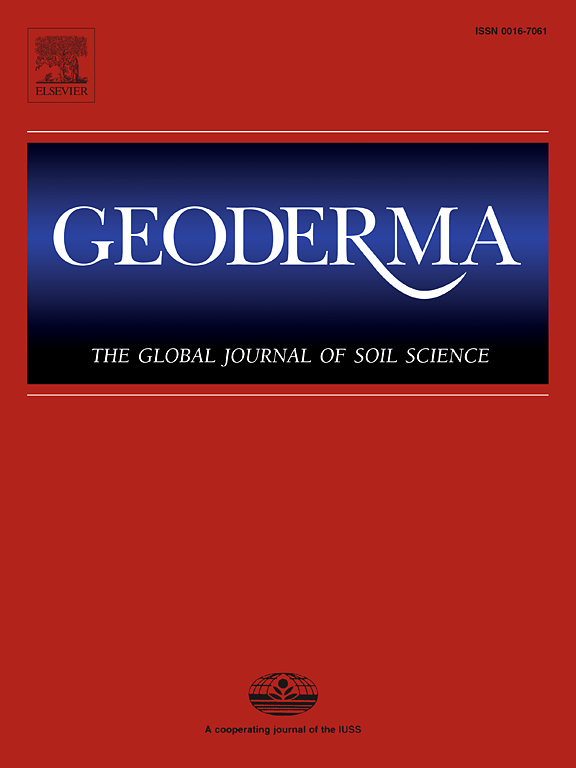温带气候土壤中胎生层的形成--岩性与成土作用(波兰西南部斯托沃韦山)
IF 5.6
1区 农林科学
Q1 SOIL SCIENCE
引用次数: 0
摘要
胎生层是由铁、锰和/或铝化合物以及有机物胶结或硬化的薄土层。胎生层是一种坚硬、连续、几乎不透水和不透气的地层,可阻止水分的垂直沥滤并抑制根系的生长。在不同的气候条件下,地层会以不同的方式形成。然而,我们并不完全了解岩性与成土作用之间的相互作用可能会促进洼地地层的形成。因此,为了揭示胎生层的形成机制,我们对波兰西南部山区由砂岩-泥岩母质发育而成的三种土壤采用了应用多代理方法(电阻率层析成像-ERT、XRD、57Fe 莫斯鲍尔光谱、体质地球化学、土壤微观形态学和 14C 测定),以揭示胎生层的形成机制。ERT 反演模型和土壤调查数据表明,剖面中存在石质不连续性。土壤微形态学数据证实,在不连续性的稍下方形成了胎生层。胎生层的放射性碳年代跨度为 2.2 ka 到 4.8 ka,表明较潮湿的条件有利于胎生层的形成,这与我们的矿物学结果相吻合。铁酸盐是胎生层中主要的氧氢氧化铁。微形态学数据显示,在铁锈层形成后,可能出现了粘土迁移阶段,而后荚果化成为主要的成土过程。这一序列表明,薄铁锅的形成可以不受其他过程的影响,并且可以(至少其中一部分)在plocic地层形成之前就已经存在。铁锈层会导致表土和地下地层发生严重的水文变化。因此,土壤中的积水会将其转化为积水溶胶(Stagnosol)或积水溶胶(Planosol),并导致当地植物群落和生态系统的演变。本文章由计算机程序翻译,如有差异,请以英文原文为准。
Formation of placic horizons in soils of a temperate climate – The interplay of lithology and pedogenesis (Stołowe Mts, SW Poland)
A placic horizon is a thin soil layer that is cemented or indurated by Fe, Mn, and/or Al compounds as well as by organic matter. The placic horizon is a hard, continuous, and nearly impermeable and impenetrable horizon that retards the vertical leaching of water and inhibits the growth of roots. Placic horizons can develop under different climates and in various ways. However, we do not fully understand the interactions between lithology and pedogenesis that might promote placic horizon formation. Therefore, to shed light on the mechanisms of placic genesis, we used an applied multiproxy approach (electrical resistivity tomography – ERT, XRD, 57Fe Mössbauer spectroscopy, bulk geochemistry, soil micromorphology and 14C dating) for three soils developed from sandstone–mudstone parent materials in mountainous areas of SW Poland, to shed light on the mechanisms of placic horizon genesis. The ERT inversion models and soil survey data indicate lithic discontinuities in the profiles. Soil micromorphology data confirmed that a placic horizons formed slightly below the discontinuity. Radiocarbon ages of the placic horizon span from 2.2 to 4.8 ka and suggest that more humid conditions were favorable for the formation of a placic horizon, which aligns with our mineralogical results. Ferrihydrite is the major Fe oxyhydroxide in the placic horizon. Micromorphological data showed that after the formation of the placic horizon, a phase of clay migration might have occurred, while later, podzolisation took over as the main soil-forming process. This sequence shows that thin iron pans can develop independently of other processes and can exist (at least some of them) before the development of a spodic horizon. A placic horizon causes severe hydrological changes in the topsoil and subsurface horizons. Thus, water stagnation in the soil transforms it into a Stagnosol or Planosol and it’s responsible for the evolution of local plant communities and the ecosystem.
求助全文
通过发布文献求助,成功后即可免费获取论文全文。
去求助
来源期刊

Geoderma
农林科学-土壤科学
CiteScore
11.80
自引率
6.60%
发文量
597
审稿时长
58 days
期刊介绍:
Geoderma - the global journal of soil science - welcomes authors, readers and soil research from all parts of the world, encourages worldwide soil studies, and embraces all aspects of soil science and its associated pedagogy. The journal particularly welcomes interdisciplinary work focusing on dynamic soil processes and functions across space and time.
 求助内容:
求助内容: 应助结果提醒方式:
应助结果提醒方式:


